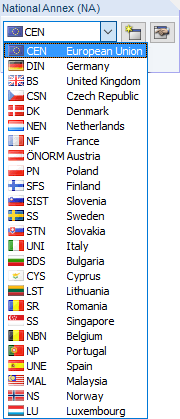Eurocode 3 [1] regulates the draft, design, and construction of steel structures in the member states of the European Union. Mit den Zusatzmodulen RF-STAHL EC3 (für RFEM) und STAHL EC3 (für RSTAB) bietet Dlubal Software leistungsstarke Werkzeuge zur Bemessung von Stahltragwerken an.Länderspezifische Regelungen sind in den Modulen durch verschiedene Nationale Anhänge berücksichtigt. In addition to the parameters included in the program, you can define your own limit values or create new National Annexes.
Dieses Handbuch beschreibt die Zusatzmodule der beiden Hauptprogramme gemeinsam unter der Bezeichnung RF-/STAHL EC3.
RF-/STEEL EC3 performs all typical ultimate limit state designs as well as stability and deformation analyses. In the ultimate limit state design, the add-on module considers the effect of various loadings. It is possible to choose among the interaction formulas given in the standard. An essential part of the verification according to Eurocode 3 is the classification of the cross-sections to be designed into the classes 1 to 4. Dadurch wird die Begrenzung der Beanspruchbarkeit und Rotationskapazität durch lokales Beulen von Querschnittsteilen überprüft.RF-/STAHL EC3 ermittelt die c/t-Verhältnisse der druckbeanspruchten Querschnittsteile und nimmt die Klassifizierung automatisch vor.
In the stability analyses, you can specify separately for each member or set of members whether flexural buckling in y- and/or z-direction is possible. You can also define additional lateral restraints in order to represent the model close to reality. In addition, the stabilizing effect of purlins and sheets can be taken into account by rotational restraints and shear panels. Based on the boundary conditions, RF-/STEEL EC3 determines the slenderness ratios and elastic critical buckling loads. The elastic critical moment for lateral-torsional buckling required for the lateral-torsional buckling analysis can be determined automatically or specified manually. The program takes into account the load application point of transverse loads, which has a decisive effect on the torsional resistance.
RF-/STAHL EC3 führt auch den Brandschutznachweis nach EN 1993-1-2 [2]. Die Bemessung erfolgt dabei nach dem vereinfachten Berechnungsverfahren auf der Tragfähigkeitsebene.Als Brandschutzmaßnahmen können Bekleidungen mit verschiedenen physikalischen Eigenschaften gewählt werden.
The serviceability limit state represents an important design for structures with slender cross-sections. Load cases, load combinations, and result combinations can be assigned to different design situations. The limit deformations are preset by the National Annex and can be adjusted, if necessary. In addition, it is possible to specify reference lengths and precambers that will be considered accordingly in the design.
Mit RF-/STAHL EC3 lassen sich auch Bauteile aus nichtrostendem Stahl gemäß EN 1993-1-4 [4] nachweisen.
Wenn eine Lizenz für die Modulerweiterung "RF-/STAHL Kaltgeformte Profile" vorliegt, ist auch die Bemessung kaltgeformter Bauteile nach EN 1993-1-3 [3] möglich.
The add-on module provides an automatic cross-section optimization with the possibility to export modified cross-sections to RFEM or RSTAB. Separate design cases allow for the flexibility to analyze individual structural components in complex structures.
Like other add-on modules, RF-/STEEL EC3 is completely integrated in the RFEM or RSTAB program. Thus, the design-relevant input data is preset when you have started the add-on module. Subsequent to the design, you can use the graphical user interface of the main program to evaluate the results. As they are also included in the global printout report, the entire verification can be presented in a consistent and appealing form.
This manual also describes the following two module extensions for RF-/STEEL EC3:
- RF-/STAHL Wölbkrafttorsion
- RF-/STAHL Plastizität
- RF-/STAHL Kaltgeformte Profile
We wish you a pleasant and successful working with RF-/STEEL EC3.
Your Dlubal Software team
Literature
[1] Eurocode 3: Design of Steel Structures – Part 1‑1: General Rules and Rules for Buildings, EN 1993-1-1:2005. Berlin: Beuth Verlag GmbH.
[2] Eurocode 3: Design of Steel Structures – Part 1-2: General Rules – Structural Fire Design, EN 1993-1-2. Berlin: Beuth Verlag GmbH.
[3] Eurocode 3: Design of Steel Structures – Part 1‑3: General Rules – Supplementary Rules for Cold-Formed Members and Sheeting, EN 1993‑1‑3:2010‑12. Berlin: Beuth Verlag GmbH.
[4] Eurocode 3: Bemessung und Konstruktion von Stahlbauten − Teil 1-4: Ergänzende Regeln zur Anwendung von nichtrostenden Stählen. Beuth Verlag GmbH, Berlin, 2007.
